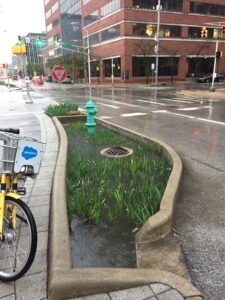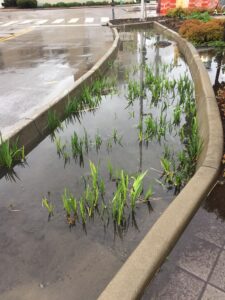Ethan, Cultural Trail Horticulture Manager

Stormwater planters are an element of outdoor landscape that are often overlooked or misunderstood. In this week’s Lunch and Learn, we dug into the nitty gritty of why stormwater planters are critical to our city’s infrastructure.
What are they?
Stormwater planters, also called rain gardens or bioswales, are a type of green infrastructure that helps manage rainwater. Typically when it rains in Indianapolis, water is directed to the drains we see along curbs. From there, it travels through a series of underground pipes until it is cleaned at a water treatment facility and dumped into the White River.
How do they work?
With green infrastructure like stormwater planters, water is directed into a sunken plant bed. Once in the plant bed, it slowly drains into the soil. The plants and soil then act as a cleaning system, filtering out sediment, chemicals and trash. This slowing of the water also helps add capacity to the system and increases the amount of rain it takes to flood a road. Not only is this much cheaper to process, it helps recharge local groundwater and keeps water in the ground for plants to use.
What plants are best suited for stormwater planters?
The plants in stormwater planters have to be tolerant of drought, flooding, harsh soil conditions and be able to hold their own against weeds. The plants that I would recommend are yellow fox sedge, Frank’s sedge, Lance-Fruited oval sedge, fox sedge and Blue Flag Iris – all included in the Trail’s stormwater planters.
How the ICT uses stormwater planters
The Cultural Trail has 83 individual stormwater planters that can be found between the Trail and the roadway. These planters cover 25,000 square feet and are estimated to capture and process three million gallons of stormwater every year.
Do it yourself!

Stormwater planters and rain gardens are something that can be implemented in your own yard. They help with run off, divertyour pollutants (don’t be offended, all of our yards have them!) solve wet spot problems and provide a diversity of plant material for wildlife. Missouri Botanical Garden has a great guide on what to know before installing a residential rain garden as well as info about other plants that thrive in rain gardens. If done right, they become many people’s favorite landscaped areas!
Interested in learning more from the ICT staff? Join us Wednesdays at noon on Instagram Live as we continue our Lunch and Learn series. Watch this week’s episode about Stormwater Planters here. Want to get your hands dirty along the Trail? Help us take care of the Trail’s landscape at Landscaping and Lagers every Wednesday from 5:30-7:50 p.m., or drop-in to volunteer Tuesdays through Thursdays from 9 a.m. – 3 p.m. and we’ll supply the tools you need to spruce up the Trail.